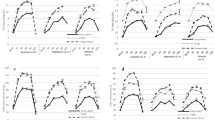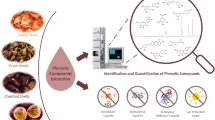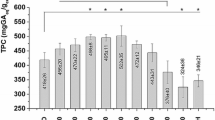Abstract
In this work, extracts from various lignocellulosic wastes were analyzed with the aim of applying them to prevent colour ultraviolet degradation of dyed veneers used for board coating. Chestnut fruit (Castanea sativa) shell and bur, barks from Pinus pinaster, Eucalyptus globulus, Quercus frainetto and Quercus robur and wood from Tilia cordata were extracted using water or aqueous solutions of sodium sulphite and/or sodium hydroxide. The extracts were analyzed for their antioxidant activity (using the ferric reducing antioxidant power, the free radical DPPH and the free radical ABTS essays), totals phenols content, molecular weight distribution and phenolic composition. Except for chestnut bur and steam peeled chestnut shell whose water extract was the best, the best antioxidant properties were obtained for the 2 % sodium sulphite extracts. Extracts from pine bark and steam peeled chestnut shell, with the highest total phenols content and antioxidant activity, not only showed the best properties as bioprotectors but also high extraction yields. These extracts also presented the higher average molecular weights. Extract antioxidant properties were related to the presence of various phenolic compounds identified by reverse phase high-performance liquid chromatography electrospray ionization time-of-flight mass spectrometry: flavan-3-ols, flavonols, flavonol glycosides, dihydroflavonols and phenolic acids.





Similar content being viewed by others
References
Barreira JCM, Ferreira ICFR, Oliveira MBPP, Pereira JA (2008) Antioxidant activities of the extracts from chestnut flower, leaf, skins and fruit. Food Chem 107:1106–1113
Bruce A, Palfreyman JW (eds) (1998) Forest Product Biotechnology. Taylor and Francis, London
Cadahía E, Conde E, Fernández de Simón B, García-Vallejo MC (1997) Tannin composition of Eucalyptus camaldulensis, E.globulus and E. rudis. Part II. Bark. Holzforschung 51:125–129
Chang TC, Chang HT, Wu CL, Lin HY, Chang ST (2010a) Influences of extractives on the photodegradation of wood. Polym Degrad Stab 95:516–521
Chang TC, Chang HT, Wu CL, Lin HY, Chang ST (2010b) Stabilizing effect of extractives on the photo-oxidation of Acacia confusa wood. Polym Degrad Stab 95:1518–1522
Chang TC, Lin HY, Wang SY, Chang ST (2014) Study on inhibition mechanisms of light-induced wood radicals by Acacia confusa heartwood extracts. Polym Degrad Stab 105:42–47
Dai J, Mumper RJ (2010) Plant phenolics: extraction, analysis and their antioxidant and anticancer properties. Molecules 15:7313–7352
Diouf PN, Merlin A, Perrin D (2006) Antioxidant properties of wood extracts and colour stability of woods. Ann For Sci 63:525–534
Evans PD (2009) Review of the weathering and photostability of modified wood. Wood Mat Sci Eng 4(1 and 2):2–13
Evans PD, Owen NL, Schmid S, Webster RD (2002) Weathering and photostability of benzoylated wood. Polym Degrad Stab 76:291–303
Fernández-Agulló A, Freire MS, Antorrena G, Pereira JA, González-Álvarez J (2014) Effect of the extraction technique and operational conditions on the recovery of bioactive compounds from chestnut (Castanea sativa) bur and shell. Sep Sci Technol 49:267–277
Galiñanes C, Freire MS, González-Álvarez J (2015) UV protection effects of phenolic extracts from chestnut fruit and forest industries residues. Eur J Wood Prod. doi:10.1007/s00107-015-0937-6
George B, Suttie E, Merlin A, Deglise X (2005) Photodegradation and photostabilisation of wood-the state of the art. Polym Degrad Stab 88:268–274
Jebrane M, Sebe G, Cullis I, Evans PD (2009) Photostabilisation of wood using aromatic vinyl esters. Polym Degrad Stab 94:151–157
Laks PE, McKaig PA, Hemingway RW (1988) Flavonoid biocides: wood preservatives based on condensed tannins. Holzforschung 42:299–306
Pizzi A (1994) Advanced wood adhesives technology. Marcel Dekker Inc., New York
Re R, Pellegrini N, Proteggente A, Pannala A, Yang M, Rice-Evans C (1999) Antioxidant activity applying an improved ABTS radical cation decolorization assay. Free Radic Biol Med 26:1231–1237
Schnabel T, Musso M, Tondi G (2014) Univariate and multivariate analysis of tannin-impregnated wood species by using vibrational spectroscopy. Appl Spectrosc 68:488–494
Singleton VL, Rossi JA (1965) Colorimetry of total phenolics with phosphomolybdic-phosphotungstic acid reagents. Am J Enol Vitic 16:144–158
Szöllösi R, Szöllösi-Varga I (2002) Total antioxidant power in some species of Labiatae (Adaptation of FRAP method). Acta Biol Sxegediensis 46:125–127
Thaipong K, Boonprakob U, Crosby K, Cisneros-Zevallos L, Byrne DK (2006) Comparison of ABTS, DPPH, FRAP, and ORAC assays for estimating antioxidant activity from guava fruit extracts. J Food Compos Anal 19:669–675
Thevenon MF, Tondi G, Pizzi A (2009) High performance tannin resin-boron wood preservatives for outdoor end-uses. Eur J Wood Prod 67:89–93
Tondi G, Palanti S, Wieland S, Thevenon MF, Petutschnigg A, Schnabel T (2012) Durability of tannin- boron-treated timber. BioResources 7:5138–5151
Tondi G, Schnabel T, Wieland S, Petutschnigg (2013a) Surface properties of tannin treated wood during natural and artificial weathering. Int Wood Prod J 4:150–157
Tondi G, Thevenon MF, Mies B, Standfest G, Petutschnigg A, Wieland S (2013b) Impregnation of Scots pine and beech with tannin solutions: effect of viscosity and wood anatomy in wood infiltration. Wood Sci Technol 47:615–626
Acknowledgments
This work was financially supported by the Xunta de Galicia (Project 09DPI106) under a contract with the company ASERPAL S.A.
Author information
Authors and Affiliations
Corresponding author
Rights and permissions
About this article
Cite this article
Galiñanes, C., Freire, M.S. & González-Álvarez, J. Antioxidant activity of phenolic extracts from chestnut fruit and forest industries residues. Eur. J. Wood Prod. 73, 651–659 (2015). https://doi.org/10.1007/s00107-015-0936-7
Received:
Published:
Issue Date:
DOI: https://doi.org/10.1007/s00107-015-0936-7




